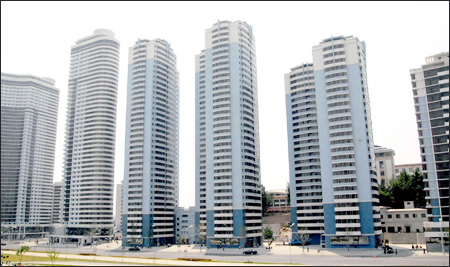Potemkin village in Pyongyang?

New high-rise apartments in the Mansudae district of Pyongyang are seen in this photograph taken Thursday by the Choson Sinbo, a pro-North Korea newspaper based in Japan. / Yonhap
Sleek and modern: The words are rarely used to describe North Korea. Yet the latest addition to the Pyongyang skyline, a set of new apartments in the central Mansudae district appears from the outside to be just that.
But while the North touts it as progress, the jury is still out on the impact of the project. Some say in lieu of difficult reforms, modernization efforts are mostly for appearances and may actually serve to highlight a widening income disparity.
Long tied to its campaign to emerge as a “strong and prosperous” state this year, the North held an opening ceremony for the Changjon Street apartment complex last week. State images show stylishly-curved buildings in a spacious plaza that reportedly includes restaurants, childcare facilities and a theater.
The street extends from Mansu Hill, where statues of late country founder Kim Il-sung and his son Kim Jong-il stand, and runs along the Taedong River.
“Pyongyang is a show city. That’s expensive,” said Aidan Foster-Carter, an honorary senior research fellow in sociology and modern Korea at Leeds University.
“Who knows what resources have gone into this one street? The point is, can and do they replicate this elsewhere – even in Pyongyang, let alone outside? I very much doubt it.”
Foster-Carter said the apartments could work to foster an unsustainable desire for consumerism among the people and highlight disparities between Pyongyang, where the political elite is concentrated, and provincial areas.
Paik Hak-soon, an analyst with the Sejong Institute holds a different view, saying the complex was both a Potemkin village and a sign of progress, noting that its modern design fell in line with efforts to advance the nation under young new leader Kim Jong-un.
“The focus of the new leader’s policy is on improving the lives of the people and housing is part of that. So they’ve decided to give a new look to the housing in Pyongyang and that’s a key thing he is doing to buy the mind of the people,” he said.
The North has long promised its people it would become prosperous by this year, the 100th anniversary of Kim Il-sung’s birth. But its economy, which runs the gamut from a planned distribution system to fledgling markets, struggles to feed and provide electricity for its 24 million people.
The apartments fall in line with recent upgrades to the city and other areas that include apartments as well as service oriented facilities such as department stores, and restaurants.
The increased activity is concentrated mainly on Pyongyang as well as cities such as Sinuiju and Wonsan, experts say.
Whether new leader Kim Jong-un, who was handed power following the December death of his father Kim Jong-il, will make reforms to the economy has been a source of debate. While he has emphasized quality of life issues during speeches, some believe any opening of the economy would risk greater flows on information, making it likely that the Stalinist state will continue to muddle along. <The Korea Times/Kim Young-jin>
























































